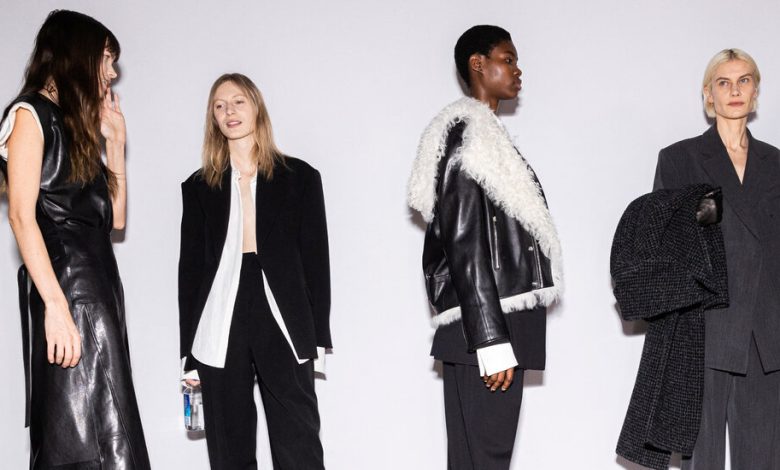The Shock of Wearable Clothes

There’s been a lot of talk over the last year or so, around dinner tables, in academia, in Congress, about how our online lives have warped our sense of self: of truth, of propriety, of time, of relationships, of who we are and how we express ourselves.
What exactly that means is starting to come clear on the runways. The endless scroll puts a premium on the viral, which itself puts a premium on the extreme and absurd — anything wackadoodle enough to stop you in your tracks, even if only for a moment. That’s how you get a show like Area’s ode to the banana, a fruity bit of sartorial punning that looked as if Josephine Baker had gone to the Mudd Club on Mars and was set to the tune of an insect’s buzz.
Buzz! Get it?
In the face of such gravitational pull, making quiet clothes, the kind that inspire thoughts of shopping, rather than posting, can seem like a radical move. Yet there’s a growing movement in that direction among a subset of normally unrelated designers that suggests it may, in fact, be a trend.
Case in point: Jack McCollough and Lazaro Hernandez of Proenza Schouler, who, 20 years after they introduced their brand, announced in a preview: “There’s no silhouette, no theme.”
No silhouette? No theme? What does that mean?
It means, effectively, a return to first principles instead of detours to far-flung places with corresponding detours into, say, extreme ruffles. Once upon a time, Mr. McCollough and Mr. Hernandez were the dressmakers to the Chelsea set — cool enough to be downtown arty but smooth enough to dress the gallerist who dreamed of being the next Gagosian. Now that woman has grown up, had kids and is busy multitasking in the face of the current-events storm.



Looks from the Proenza Schouler fall 2023 collection.Credit…Phographs by Giovanni Giannoni/WWD, via Getty Images
Their soundtrack told the story: an assortment of diary entries by the novelist Ottessa Moshfegh, read by Chloë Sevigny (who also opened the show) and set to music by Arca. The erstwhile avant-garde, adulting. They still need stuff to wear.
Like, for example, a buttonless oversize jacket, cut wide in the shoulders and curved on the hip, then hitched with a leather string around the waist, over a midiskirt and crushed leather boots with an isosceles-shaped heel. Like a tweed coat with a big, spread collar cut like a pyramid at the back of the neck, with a plain, gray knit and carrot-shaped, gold leather pants. Like knits with sequins embedded in the yarn, pulled to the side and twisted off-center to create a built-in slouch, as if the wearer had stuck out her hip in a permanent harrumph.
The allure was in the details and the sense of interior life: the center seam in the back of a jacket sliced and unzipped to show a sliver of shirt; carwash skirts that kicked wide with every step to reveal a glimpse of crocheted fringe on a velvet lining. So much going on, just underneath.
Those details were a reminder that just because a garment doesn’t scream, “Look at me!” it doesn’t mean that it’s boring or corporate or pandering; that “wearable” is not necessarily a derogatory term and can encompass the interesting; that sometimes “just clothes” is enough.
That’s what Paul Helbers, the co-founder and designer of Fforme, a newish brand now in its third season, is also trying to prove — and he’s succeeding, with a small collection that treats every garment as an iteration of its platonic ideal, whether it’s a deceptively simple puffer jacket with the air of an opera cloak or a pair of leather pants with an elastic waist gathered in 40 pleats to settle imperceptibly on the body. (Mr. Helbers used to work at the Row and Martin Margiela, and it shows.)



Looks from the Eckhaus Latta fall 2023 collection.Credit…Photographs by Madison Voelkel
And it’s what Mike Eckhaus and Zoe Latta of Eckhaus Latta were considering: how to be “more dedicated to everyday clothes and how to make those interesting, rather than making an absurd gesture and then something very basic,” according to Ms. Latta.
To wit: covered-up suiting and long-sleeved dresses turned inside out to expose the inner seams, which became a sort of road map unto themselves with gaps left here and there to expose flashes of skin, like a glitch in the system. Wide-wale corduroy sweatpants in dirty, Easter egg pastels with poppers up the side that could be opened or closed as desired. An asymmetric linen wrap skirt that climbed unexpectedly over one knee. (Also: Jon Gries, a.k.a. Greg of “The White Lotus,” in a surprise modeling debut.)
It made for a slightly pervy materiality combined with a play on what you see and what you don’t, putting the decision-making power into the hands of the wearer, leaning into the body (no matter the age, size or gender) as a private source of strength — emphasis on the private. That may be where all this is going.
